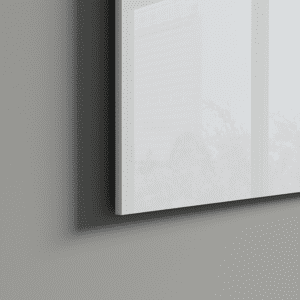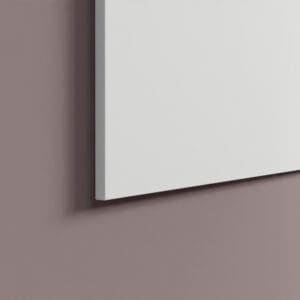

It’s no secret that Claridge writing surfaces are the best you can buy, and just like any premium product they require routine maintenance to ensure they continue to perform at the top level for years. Below we will detail the best methods to clean and maintain our three different surfaces.

Claridge glass dry erase whiteboards are stylish, functional, and a great addition to any environment where ideas are born. They are also guaranteed for 10 years. Maintaining your Claridge glass markerboard is easy and as long as the proper methods are used it can be periodically cleaned without damage. The first step is using the correct cleaner, we recommend using our 683 Board Cleaner, Windex®, or any other standard glass cleaner. What you want to avoid are abrasive type cleaners as they may dull or “pit” the surface of the glass.
Next you need to make sure you are wiping off marker residue and cleaning the board with a soft cloth, towel, microfiber eraser cloth, or rare earth magnetic eraser. The most important word to remember here is soft; our glass boards are scratch resistant, but hard or abrasive materials have the potential to scratch your board and that is the last thing you want for this beautiful surface.
One thing to remember, and can be easy to forget, is to make sure you clean your eraser cloths or erasers regularly to remove any ink residue build up. Cloths can be cleaned with an everyday washing machine with like colors and no bleach, tumble dry low. The felt surface of our erasers can be wiped off with any microfiber cloth or even paper towels but try to avoid using anything that could possibly snag the felt material and cause damage.
Lastly, one great thing about Claridge glass boards is your options for markers are limitless. Glass surfaces are less porous than porcelain so they will not have any issues with ghosting. We certainly would recommend our solvent based markers as they tend to look more bold on the reflective and low contrast surface but any type and color will work so experiment and see what works best for you.
Do not use permanent markers on your glass markerboard, they do not have dry erase features. However, should someone mistakenly use one on the surface there is nothing to fear as it can be removed using a standard glass cleaner.
Finally, avoid leaving tape or other adhesives on the writing surface for long periods of time as they may leave a sticky residue. That said, just like with the permanent markers this can be removed with glass cleaner or in the case of more stubborn substances isopropyl alcohol.

Under normal usage and maintenance Claridge LCS porcelain writing surfaces are guaranteed for the life of your building. This said, you may ask, what is normal maintenance? Care for your LCS porcelain markerboard starts when you first receive your product. Every board will be delivered with a protective film on the surface to protect it during transit. Once the board has been installed and is ready for use you will need to remove that covering by carefully peeling it back and away from the writing surface. From here you will need to complete a very important step in ensuring the performance of your product, the initial preparatory cleaning. First, using a clean, dry cloth and a non-abrasive liquid cleaner, gently clean the entire surface. Then, use another dry cloth to wipe the entire surface to remove all dirt and residue that can be left behind after removing the protective film. Next, using clean water rinse the entire surface and lastly take a dry towel and dry the entire surface. This may seem simple but failing to perform this initial cleaning may cause under-performance of your product.
Now that the initial cleaning is done, lets discuss routine maintenance. The first step is using the correct cleaner, we recommend using our 683 Board Cleaner, a similar ammoniated cleaner, or even Windex® containing ammonia.
The next step is ensuring that you are using the correct type of dry erase markers as they are not all created equal. We strongly urge you to use solvent based markers and they are available for purchase by contacting Claridge customer service. Water based markers, also referred to as low odor, have a longer drying time which creates a more intense bond between the ink and the writing surface and will lead to ghosting over time, even with proper cleaning.
It is also important to clean your board regularly. It is recommended that you clean the writing surface at least twice a week, especially if it is seeing daily use, and note that leaving ink on the board for an extended period of time can cause ghosting so it is also imperative that you erase on a regular basis. If information needs to be left up for a few days and ghosting does occur you may refer to the list of correct cleaners above that will help return your writing surface to its original condition.
One last thing to remember, and can be easy to forget, is to make sure you clean your eraser cloths regularly to remove any ink residue build up. This can be done with an everyday washing machine with like colors and no bleach, tumble dry low.
We have talked about the best writing tools for your board but also recognize that mistakes happen. If you or someone else accidentally uses a permanent marker on your LCS surface, have no fear as it can be fixed. Simply moisten a dry, clean cloth with isopropyl alcohol, wipe the board in a circular motion to loosen the residue, rinse with clean water, and wipe dry. Repeat as needed until all residue has been removed.

Claridge LCS chalkboard writing surfaces combine excellent erasability with wear resistance that will not ghost, yield less chalk dust for a cleaner, healthier environment, and are guaranteed for the life of your building. Just like the markerboards, chalkboards require some initial preparatory procedures to perform optimally which again starts by removing the protective film from the writing surface. From here you will need to complete a very important step in ensuring the performance of your product, the initial “chalking in” and preparatory cleaning. First, using the long side of a piece of chalk, we recommend pure white chalk without a wax surface, coat the entire surface of your board, think of this like seasoning a brand new cast iron pan. Next, erase the board with a latex or felt eraser. (Make sure to clean your erasers regularly for optimal performance.) After this you will need to clean the surface with clean, warm water using a phosphate-containing cleaner, such as Extran™ MA 02, and rub well with a kitchen sponge and then lastly rinse well with clean water and wipe with a good squeegee. Once these steps are complete just allow the board to dry completely and you are ready to go. It’s very tempting and exciting to just start writing your ideas on your brand new chalkboard but the above process is absolutely necessary as failing to perform this initial preparation may cause under-performance of your product.
After performing your initial set-up, cleaning is easy because you already know what to do. Just follow the steps in the above preparation section starting with the first step after the chalking in process. Claridge recommends boards that get regular use be cleaned two to three times a week and in the case of boards that get heavy usage a daily cleaning may be required.
If your board gets some stubborn residue on it the cleaning is just as easy, once again you have done it already. Grab your phosphate-containing cleaner in water, wash the surface, squeegee, and allow the surface to dry completely, repeating as needed.
We hope that this has given you some insight into how to properly maintain your writing surfaces and for more information on Claridge product maintenance and warranties please visit the resources page on our website, https://claridgeproducts.com/resources-new/.
